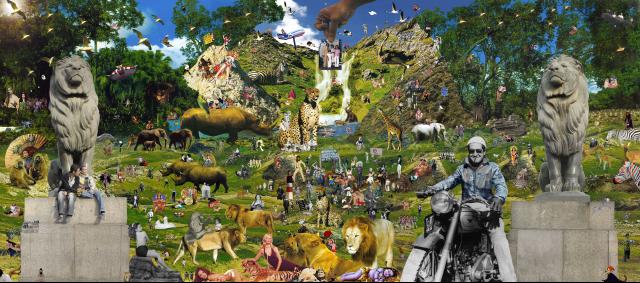LARA BALADI
Born 1969 in Beirut, Lebanon. Lives and works in Cairo, Egypt.

baladi_justicemother_2007.jpg
Lara Baladi is a Cairo-based photographer and multimedia artist. Her versatile practice includes photomontage, sound, video and installation. She produces highly imaginative artworks that address personal and collective memory, representing a hybridity of cultures that also reflects her own experience of living in Beirut, Paris, London and Cairo.
In Sandouk El Dounia (‘The World in a Box’) (2001), she made an assemblage of a claustrophobic array of dreamlike images from the modern world, a collection of 900 small photographs transferred to a large, digitally woven tapestry. Starting with ‘Dolly’ – the first cloned sheep – each image depicts a frenzied urban environment inhabited by fairies, manga characters and caricatured action heroines captured in enclosed spaces or dark stairwells. This parallel urban world was in stark contrast to her previous work, Oum El Dounia (‘The Mother of the World’) (2000). In this, she evoked a range of fairytales and classical tales, such as Alice in Wonderland, set in a vast sun-scorched desert landscape. In this hyper-real fantasy, costumed characters such as a wizard and a hookah-smoking giant purple worm traversed the golden sands, creating an amalgam of eastern and western mythologies rich in symbolism and wonder. In Diary of the Future (2007–10), a response to her father’s recent fatal illness, she put together an ensemble of four projects using the Arab popular tradition of drawing portents from the residue left after drinking Turkish coffee to construct a narrative. Here she engaged in a complex and personal quest, looking for answers to notions of death, mediation, communication, popular beliefs, and the ephemeral aspect of time:
"The collective future of all the people accompanying my father in his last days became my point of focus. How could I show the beauty and the tensions, the sadness and the joy of this communal moment of sharing, which was neither morbid nor melancholic but rather dramatic, excessive and strangely positive?
The coffee readings assumed a great significance to record this period. The prophetic words assumed a real poignancy. They began to articulate and make sense of the situation – spreading beyond the confines of Sunday lunches, the coffee dregs contained a popular shared language that was both personal and traditional. In the months that followed, every person who visited my father would drink a coffee and unwittingly become part of an elaborate ceremony, with no clear beginning or middle but with a determined end – my father’s death and the period of condolences (February 2008). They followed my instructions religiously, drank, turned the cup upside down, turned it round three times in the saucer and tapped the top twice. The cups were then labelled with name and date and carefully put to one side. Everyday I photographed the cups, the saucers, the labels and other details revolving around the same apparently banal subject. This very direct photographic documentation charted a period of great intimacy with my close family, friends, dedicated doctors and the nurses looking after my father – a period of great emotional intensity and difficulty, which we all experienced yet shared."
In recent wall-sized photomontages, Baladi has reflected in a characteristically surreal way on the Islamic ideal of The Garden of Allah, interpolating her idiosyncratic interpretations with images of her family. Perfumes & Bazaar, the Garden of Allah (2006) from this series of works is shown in Sydney. In this, a large gilded frame leads you into a fantastic garden where cherubs, pin-ups and tiny creatures play and pose. The artist inserts framed paintings and portraits throughout the scene, which contrasts with the artist’s presentation of the work – resembling wallpaper, and unframed, so the viewer is engulfed in the imagery.
puma.creative Mobility Award recipient.
Selected Solo Exhibitions
2008 ‘Surface of Time’, B21, Dubai, Emirates
2006 ‘Towards the Light’, Images of the Middle East Festival, Copenhagen, Denmark 2004–05 ‘Kai’ro’, BildMuseet, Umea, Sweden (travelling exhibition) 2002 ‘El Fanous El Sehry’, Townhouse of Contemporary Art, Cairo, Egypt
Selected Group Exhibitions
2008–09 ‘Borg El Amal’, 11th Cairo International Biennale, Cairo, Egypt 2008 ‘New Ends, Old Beginnings’, Liverpool Bluecoat Gallery, UK
2007 ‘Still Life’, 8th Sharjah Biennial, Sharjah, Emirates
2006–08 ‘Snap judgments’, International Center of Photography, New York, USA 2004–07 ‘Afrika Remix’, Museum Kunst Palast, Dusseldorf (travelling exhibition)
Selected Bibliography
Kai’ro, exhibition catalogue, BildMuseet, Umea, 2004
Le désert, Actes Sud, Thames & Hudson and Fundacion La Caixa, Arles, Paris 2000
Gerald Matt, Interviews 2, Verlag Walther König, Köln, Kunsthalle Wien, Vienna, 2007
Naomi Rosenblum, A World History of Photography, Abbeville Press, New York, 2008
Jérôme Sans, In the Arab World … Now, Galerie Enrico Navarra, Paris, 2008




























